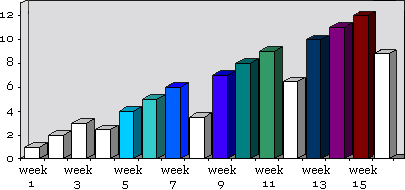Loading and recovery
The physical effect of practice arises through the combined effect of loading and the following rest period. In order to get an improving effect from practice, you will need to maintain the balance between rest and physical and mental loading.
Volume practice creates a solid base for top-level performance. Volume loading brings about gradual changes, the results of which are seen after several months work. A typical goal would be to change the structure of certain muscles or connective tissues.
Power practice is required for the fine-tuning needed to reach top form. Power loading has primarily functional effects that can be quickly seen but do not last long. It can be used to raise each musicians performance to his or her maximum level in several weeks.
Skill practice employs the overload principle. Performances at the upper limit of your skills are repeated over and over again with increasing tempo, and aiming for perfection. Skills and speed can be practiced every day and, for example, speed and suppleness exercises can also help lighten a training day if you are doing a session consisting of short blocks of lighter pieces properly interspaced with breaks. You can't exercise your skills when you are tired or overloaded.
Determination
Achieving balance between improving and performance enhancing practice will lead to a gradual improvement in performance, long-term development, and permanent results. Determined practice will strengthen all the basic attributes of your playing. Performance enhancing exercises will help you reach your own personal top form at the crucial moments of a period. Continual development is only possible if you constantly maintain your basic playing attributes.
Finding a practice rhythm
In order to improve your basic playing attributes, youll need practice periods of at least 34 weeks. The training effect will level out after 68 weeks at the latest, and your developmental curve will take a downturn unless you alter your practice programme.
Dividing your practice into periods will help you to improve different attributes in turn, while also maintaining other attributes at the same time. Distinct periods increase the improving stages of your practice and boost strength and endurance in particular. Alternating between basic form and preparation practice periods enables optimal improvement for both key attributes and any identified weaknesses. Speed and skills are constantly maintained.
In all types of improving practice, every fourth week is always a recovery week! Week 4 should be lighter than week 1 in terms of loading. The tiny blood vessel (capillary) networks that transport energy to your muscles need time to renew themselves every fourth week. If you want to improve your overall muscle condition, you have to give your body time to renew and repair its capillaries, otherwise loading will eventually lead to overtraining.

TASK (you can send your answers to the e-mail box)
The story of Mike Model-Student, who is preparing for the spring B examination.
Plan Mikes practice for the coming spring.
How would you place these in the familiarisation/basic form period:
- orchestra period, 10 days
- holiday, 5 days (hiking in Lapland)
- one unplanned bed-ridden flu week, 7 days
Januaryearly May
- Familiarisation: 3 weeks + a light recovery week
- Basic form period: 3 weeks (for example, two basic attributes to be improved) + a light fourth week
- Basic form period: 3 weeks (a third basic attribute added) + a light fourth week
- Examination or concert preparation period: 3 weeks + a light fourth week
- Examination
